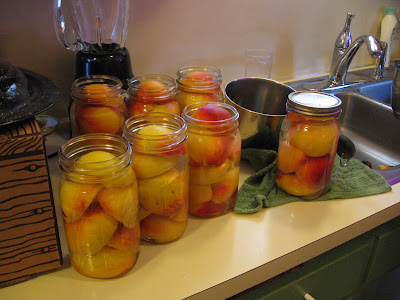The reason for my visit is because of the extensive renovations that are being done on my recently purchased house. These renovations were getting to be a little overwhelming, as Jared and I are living in the house, and it had been awhile since visiting out here, so I thought, why not visit Washington? Of course I also had a few things I wanted to accomplish while out here. I recently decided that I needed to make a quilt for my bed, and feeling fairly confident that my skill level was beyond a nine-patch, I researched a pattern that I really liked. As fate would have it, I fell in love with the Mariner's Compass pattern. With no previous experience, mom and I embarked on an interesting journey to create a beautiful work of art.
First, we had to figure out how to do paper piecing. Mom knew of the theory behind it, but never actually did any before this. After drawing my design on several pieces of freezer paper, I transferred the lines to a fusible paper that would get torn away later.
Picking out fabrics is always fun, and I chose some good ones. I decided to make the spokes of the compass two toned to give it some dimension, so I needed to get a light and dark color for each point. The yellow will be used for a center circle.
For those who are skeptical of Eb's existence, I can say, he really is real. BELIEVE me, he made sure I paid attention to him.
"I'm just trying to help you sew!"
"Am I helping yet?"
Flo pretty much ignored me, but made sure my fabrics got worn in.
Anyway, while the cats tried to distract me, I was busy putting my rectangular pieces of fabric on my compass that was separated into eighths. Once we figured out how to sew the pieces together, the process went fairly quickly. The eighths became quarters, quarters became halves, and the halves were assembled to finally have a giant medallion.
Pretty isn't it!? I was really quite pleased with how amazing and complex it looks, even though it's quite straightforward.
The next part was putting the center on to cover up the raw edges in the middle. Though she tried to get me started with the hand sewing, I found I was all thumbs when it came to this part. Luckily, mom didn't object too much to doing it for me, but insisted I do something for her. So here I am, blogging for her as punishment for being unable to sew with the smallest needle on earth. I can't complain too much, considering how much she's helped me on this project. My goal is to have the top almost completely done before I fly home on Wednesday morning. We'll see how it goes. I certainly hope it doesn't become a UFO.
The next step for my quilt will be to assemble the medallion to the background, add borders and then put the sandwich together. I am really quite pleased with how it looks, and it's very encouraging to accomplish something in such a short amount of time. To see the chaotic adventure that is my house, visit my blog at http://thegeorgiajardin.blogspot.com/ . Hopefully once things with the house settle down, I'll have my own space to do my own crafting/quilting/sewing...stuff. It's been fun, Washington!
Sarah
(Ok, we're even- Mom.)


























